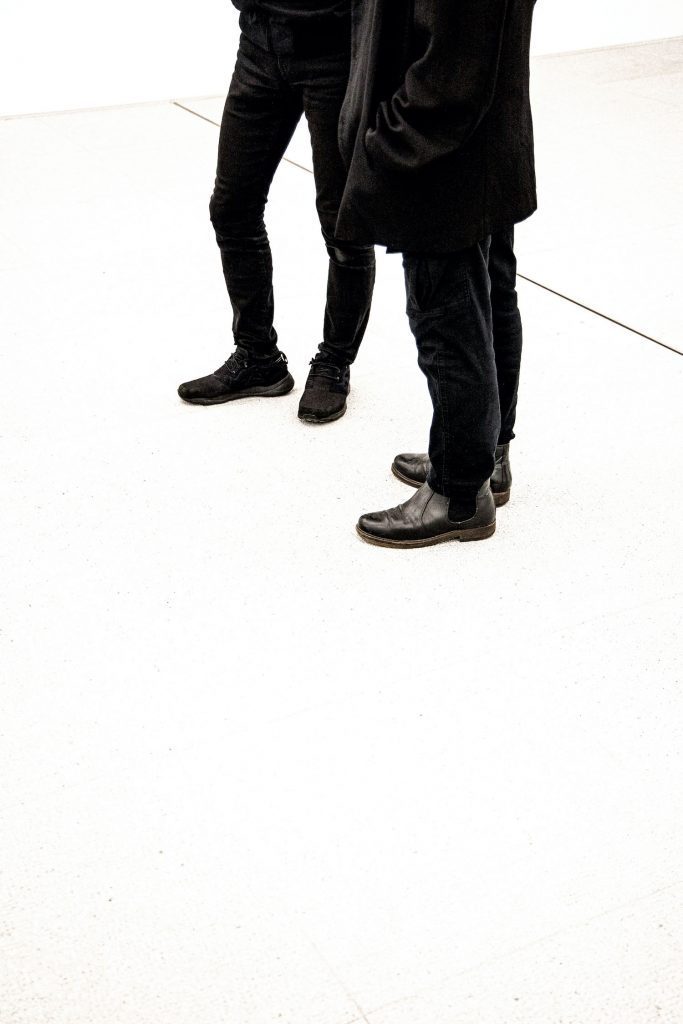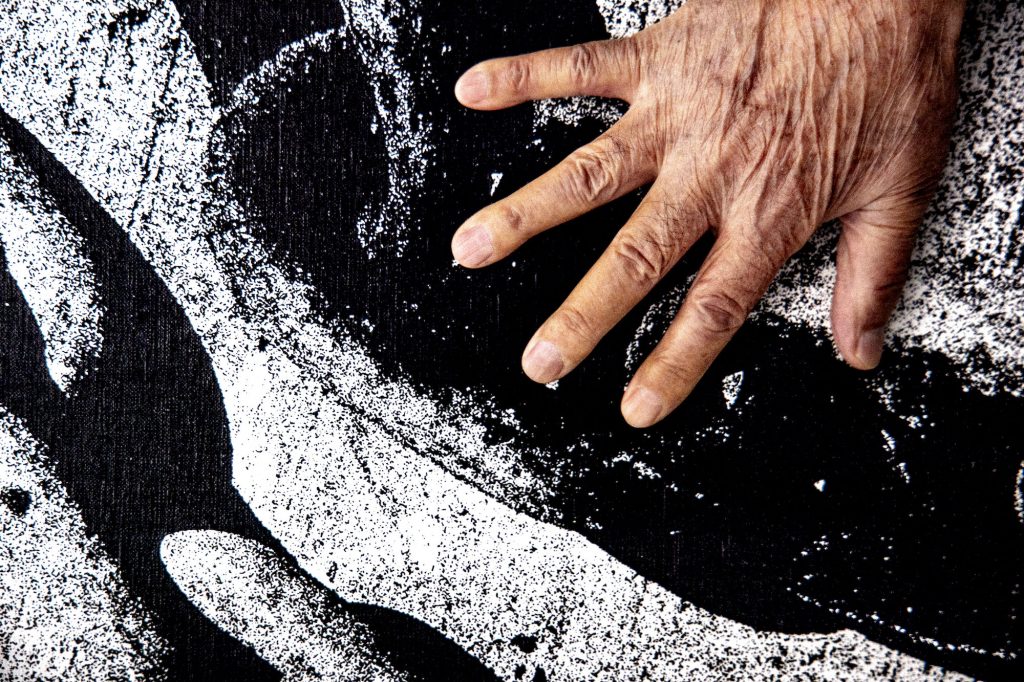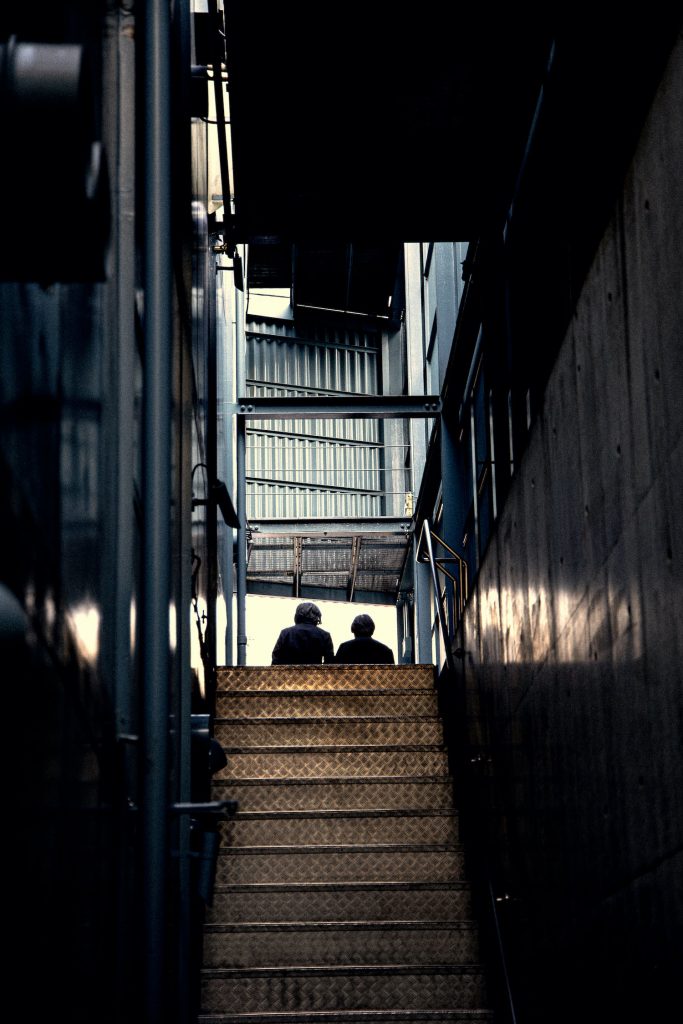“A collaboration that unfolded like a music session”: Moriyama and Kitamura reflect on all the things this legendary photo book from 29 years ago gave birth to.

Edit&Text by Yukihisa Takei(HONEYEE.COM)
Photo by Keisuke Nagoshi(UM)
Nobuyoshi Araki joined in

- How did the release of “Ao Daido" influence Moriyama-san, Kitamura-san and Hysteric Glamour?
Nobuhiko Kitamura (Hysteric Glamour): People around me and in my company completely changed the way they perceived this book after it was featured in newspapers and magazines. Since there was a time lag of a few months between each feature in fashion magazines, newspapers and photography magazines, I think this book had been sold out by the time the usual Daido Moriyama fans got to know about it. When I visited the opening reception of Moriyama-san's solo exhibition at that time, those original fans were probably like, "Who are these guys? A clothing store??" But Moriyama-san was like "Kitamura-kun, come over here,” and spoke to me in a very friendly and casual way, and when they saw this, they gradually came to approve of us. A bit after that, there was a talk between Moriyama-san and (Nobuyoshi) Araki-san in a photography magazine, and Araki-san was praising the book a lot in that interview.
Daido Moriyama: In a way, Araki-san understood this photobook the best. He just gets these kinds of things. In terms of its editing, it's all over the place. When we made it there was a lot of momentum and feelings attached to it, but forpeople who looked at it later on, it was just a bunch of unrelated things all over the place. But Araki-san is a person who understands all of that.
K: Then Araki-san rushed into our office a while later saying, "Let me make one too" (laughs).
- Oh, really? (laughs).
K: He was like, “Are you just going to commit a double suicide with Moriyama and Wataya? Give me one too!" (Laughs). So we made a photobook together.
The series that has changed Daido Moriyama

- Hysteric and Moriyama-san have released many photobooks together: No.4 "Ao (Blue) Daido" (1993), No.5 "Aka (Red) Daido" (1995) and No.8 "Daido Osaka”. Was there a plan to make a series from the beginning?
K: No, it happened very organically. We had no plan to make a series in the beginning. We made “Ao Daido" using just vertical photos, and then Moriyama-san said, "I want to make one with horizontal photos next," so I said, "Let's make another one then," and that's how we made “Aka Daido". After a while, he said, “Ao Daido and Aka Daido were both shot in Tokyo, so I want to shoot in Osaka next," and I said, "Sure, let's do it."
M: This was a time for me when I was reflecting on my way of thinking about my photography and how I was going to take my photography to the next direction. In a way, having this book made was a turning point for me. I was like, "Okay, each photograph can never be complete by itself, so I'll just fragment them all.” Since I decided to go with just the vertical photos, I took almost everything vertically for that one year. Vertical photos are, in a sense, 'fragments of the world'. So, I decided to make a photo book with horizontal photos as I had made one with vertical photos. In my photography, there is no such thing as ‘starting here and ending here’. It doesn't matter where it starts and where it ends, but I feel like it's connected to the next book. That's what I was doing with this series. So, the works shot for Hysteric became a kind of foundation for my style. My attitude toward what I wanted the photographs to be like was properly reflected in this series. So for me, the encounter with Kitamura-san and then with Hysteric was a big thing.
- I guess that story is a pleasure to hear for Kitamura-san, too?
K: Yes, it really is. I'm very happy to hear that.
M: It might sound strange, but people say things like "Moriyama's photography has changed since the 90s", but they are actually right in some way. That's because of Hysteric. That's absolutely true.

The impact of 300 copies

- As I asked at the beginning (Part 1), the influence of this book is impressive considering the number of copies was just 300. If it were 3,000 copies or so, I would get it somehow, but just 300 copies changed the way Moriyama-san thinks about his creativity as well as the way people around him and the world see him.
K: I think that's Moriyama-san’s power. I don't think that would have been the case if I had made this thick of a book with another photographer. I believe I did some good work (photobooks) after that, too. But only because the first solo artist work was "Ao Daido". I guess the timing was good in many ways for both myself and Moriyama-san.
M: I agree. It's not like I’m trying to link them or say anything at all, but my “Shashin Yo Sayonara" (1972) is still ongoing. There are many perspectives on the Hysteric series, but these three books were significant for me.
- Besides, I'm sure that this photo book and the relationship between Moriyama-san and Kitamura-san have also made people who didn't know Moriyama-san think, "Daido Moriyama is cool!".
K: I think that's true. His popularity among people in the younger generations spread like wildfire. Not gradually, but all at once. Even I became a fan when I saw it for the first time, so I had a strong desire for other people to know more about Moriyama-san. However, 300 copies were the maximum I could do (laughs). Also, it was a surprise that even though the number of copies was that small, people overseas who found out about the book spread the word, and it was this "Ao Daido" that led to the later collaborations with overseas artists and the creation of various artworks.

- Can you talk about any specific examples?
K: I showed “Ao Daido" to Patti Smith and she said, "You're not only making your own clothes, but you're also supporting such a great photographer.I'm happy to see what you do." Then she invited me backstage, wore a T-shirt I designed and let me take a portrait of her. She was someone who hated the media but still she accepted me, and after the gig, she invited me backstage again and said, "I'm currently taking Polaroid photos, and when I finish I'll send them to you first, so can you make a photo book for me?" I had no reason to refuse (laughs). Then she really sent the photos to me about a year later and told me “I trust you, so show it to me when it’s done.” Then she decided to do a photo exhibition at the Parco Museum, so we launched it there. It's the same with Terry (Richardson), and I really don't think it would have expanded to something like that without this book.
“Making a photo book is like a 'music session' with the artist”

- You were a fashion brand publishing a collection of photographs by a photographer who eschews commercialism. I’m assuming this was probably not a marketing move for you. Did you have some sort of mission in your mind?
K: Well, it wasn't exactly a mission. I initially started the brand just because I wanted to be able to work with musicians one day. This “Ao Daido" was the beginning of everything. During the production of this book, I visited Moriyama-san's place at night for a drink, and edited the book in one night, but it wasn't just the production of a photo book. I don't know how to describe it, it's like a session in music, that kind of thing. So if it had been another day when we edited it, it might have been a different selection. I had the feeling that I was working with Moriyama-san in a live, session-like way. And my brand is not sophisticated, like other brands that have shown at Paris Collection or anything like that. We were really just a casual streetwear brand, but I knew that if that’s all we had that would be the end of the brand. To spread the name Hysteric Glamour, it wasn't enough to just sell clothes. One of the ways to overcome that was to work with people from different industries and with different sensibilities, and since Japanese contemporary photographers are not that well known abroad, I thought it would be good if I could make a book with them. At that time, smartphones and digital technology were not that common.
M: Yeah, that’s true.
K: It was a time when the only products you could make were vinyl, books and that kind of thing. Today, collaborations are very common, but back then there was no such thing, so it was like a new and exciting game. It's probably not appropriate to call it a game though.
M: Well, it was definitely just for fun.

- That’s what you call a real collaboration. In the fashion scene today, collaboration is more about business, but it makes more sense to me to call what Kitamura-san has done (with Moriyama-san’s books and others) as “sessions”.
M: It's not like I could have done it because I talked a lot about photography with Kitamura-san and everyone else. It's more like it was the result of our encounters. It took the form of a book, but it wasn't made based on philosophy or theory. I worked with Kitamura-san for a few years, but we didn't talk about fashion or photography, we just got together and this book is the result of that. It's not about fashion, it's not about photography. That's what this book is about.
“Photographs come back to life, over and over again”

- Satoru Arai-san, the gallerist here, was largely influenced by “Ao Daido" at the time, which led to the re-release of the book.I think it is also because Kitamura-san and Moriyama-san had an impact on the younger generation. How do you feel about it?
K: I was honestly very happy. At the same time, I thought "Ah! I get to see Moriyama-san again" (laughs).
M: I thought about how I was going to see Kitamura-san for the first time in a long time too. It may sound dramatic to say it like this, but photographs come back to life, over and over again. It's not Kitamura-san’s or my emotions, but the emotions of the people living today that bring them back to life. It's just a single image from such a long time ago. But it gets passed on, somehow. That's the interesting thing about the natural flow of things. It's no longer a matter of meaning, after all.
K: If we had made 20,000 copies of this book back then, things might not have been the same. It’s because we made only 300 copies that it’s still being passed on.
M: That’s because the people from the gallery who arranged it this time felt something about it, for some reason. That's good. It comes across.
K: That's true. Because the shutter was pressed at that time, they found the film negative again and made new silkscreen prints this time. I believe the book is also made using the images from the original book, but there are different printing techniques now compared to the 90s. Having these kinds of things passed down to the younger generation in this way is different from something like the reissue of a classic Beatles album, I think.
M: Photographs are really about the person who sees them because there's no excuse for what you've taken, so the people who see them pass on to the future. That's what's interesting about photography.

- Like here (Gallery COMMON), the number of galleries is increasing in this Harajuku area. Over the past five years or so, the value and popularity of art have been growing. I think this is a result of what people like you two have been doing. In that sense, this exhibition is very symbolic. People who like fashion were not very much into buying art and photography until a few years ago, but that enthusiasm is also rising. How do you see this flow?
K: Well, I think it's a good thing. But I still think that the amount of information on contemporary art in Tokyo and Japan is still behind that of other countries. Artists with a certain amount of name-value always have a long queue and sell a lot of merchandise. But in regards to finding and recognizing up-coming new artists with completely new names, I think there’s still a long way to go. But I think it would be good if people start to take an interest and that kind of information spreads.
M: I don’t know much about the situation, but I do think that's just the way it is. Fashion is changing more and more, that's not a good or bad thing. Changing is a good thing, not only in photography. My photographs are being exhibited in Sao Paulo and Rome now, and people go to see them on their own. It's not necessary to ask them to see them in a certain way.
K: It is only the people who handle the works that change. Moriyama-san himself does not change. I want Moriyama-san to keep on shooting the same way he has been since he was in his 20s and 30s. That is all I hope for. I would be grateful if Moriyama-san's style that he’s had since he was in his twenties continues to evolve as an extension of the same style, and is also appreciated by the world.

- Now that you two are reunited like this, do you have any aspirations to make another photo book?
M: Well, you know, we'll do it again sometime, somewhere. I'm not the same age or anything as I used to be, but maybe I can do it when I have that passion again. It’s nice if I do, but it’s fine even if I don’t. But somewhere, we might be able to do something unexpectedly.
K: Starting with “Ao Daido", I would visit Moriyama-san's place, drink together and get wasted, and I always would go home very happily in the bright yellow morning light. We were talking about nothing particular, but I would be like, “Today was fun, I learned a lot again today.” t. That's why I thought to myself that although we hadn't had the chance to meet for more than ten years, there will definitely be another time, and when we meet, time will no longer matter.
M: Yeah, if we meet in another way, we might make something else. And it might not be a photograph.
- Is there anything you would like to tell each other at the end?
M: I just wante Kitamura-san to make a T-shirt for me.
K: I'll totally make one (laughs).
M: I love it when my picture is randomly used on a T-shirt. So when I happen to see someone wearing it, it makes me happy. It makes me happier than seeing my book (laughs). So I'll see you soon again sometime.
K: I'll think of something so let me propose an idea. I saw Moriyama-san working with the EVISEN skateboarders and others, and I was always like "I'm jealous" (laughs).

Daido Moriyama
Photographer
Born in 1938, he began his career as a freelance photographer in 1964. Awarded the Newcomer's Award of the Japan Photography Critics Society, the Photographers Society of Japan's Annual Award, the 44th Mainichi Art Award, the German Photographers Society Award and the Hasselblad International Photography Award. One of Japan's leading photographers.
Nobuhiko Kitamura
Fashion designer
Born 1962. After graduating from technical school, joined Ozone Community in 1984. Launched Hysteric Glamour. His streetwear based on rock and art quickly became popular and became a major movement. He has also closely worked with overseas musicians and has collaborated on many projects, as well as working with photographers from Japan and internationally on a series of nearly 30 photo books.
https://www.hystericglamour.jp
For the information on the exhibition and photo book, check here.
[Editor’s note]
When this talk had been confirmed and also exclusively to HONEYEE.COM, I felt honoured but also trembled with the responsibility. I’ve known Kitamura-san since my days at EYESCREAM, but this was actually the first time I had the opportunity to speak to him for an interview. Moreover, it was a talk with world-renowned photographer Daido Moriyama-san. I’ve put all my effort as an editor, but I was so drawn into the conversation that I felt like I was just listening to them for an hour. Just that, it was a fruitful interview with more than enough. Butit was enough to make a very fruitful interview. I hope many people will read this. (Takei)
